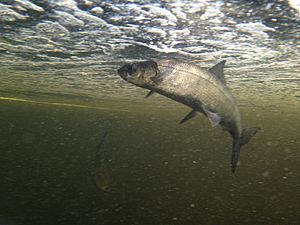Atlantic whitefish facts for kids
Quick facts for kids Atlantic whitefish |
|
|---|---|
 |
|
| Conservation status | |
| Scientific classification | |
| Synonyms | |
|
The Atlantic whitefish (Coregonus huntsmani) is a special type of fish. It is part of a group called coregonines. This fish lives in freshwater lakes in Nova Scotia, Canada. It is very rare. Today, it is only found in the Petite Rivière watershed. These fish are "landlocked." This means they live their whole lives in freshwater.
In the past, Atlantic whitefish also lived in the Tusket and Annis rivers. Those fish were "anadromous." This means they would travel to the ocean's salty water to feed. But they would return to freshwater to lay their eggs.
About the Atlantic Whitefish
The Atlantic whitefish was first named Coregonus canadensis. But its name was changed in 1987 to Coregonus huntsmani. People also call this fish the Acadian whitefish or sault whitefish.
What It Looks Like
The Atlantic whitefish has a body shape like a salmon. Its sides and belly are silvery. Its back is dark blue to dark green. The fish that live in lakes eat insects and small fish. Scientists have not yet seen Atlantic whitefish reproduce in nature.
A Rare and Protected Fish
The Atlantic whitefish is very unique. It is genetically different from other whitefish. For example, it is different from the lake whitefish (Coregonus clupeaformis). It is also different from the cisco (Coregonus artedi). These other whitefish are found across North America.
Because it is so rare, the Atlantic whitefish is an endangered species. The World Conservation Union first listed it as endangered in 1986. Then, in 1996, it was listed as vulnerable. Nova Scotia has laws to protect this fish. It is against the law to catch Atlantic whitefish under the Canadian Fisheries Act.
See also
 In Spanish: Coregonus huntsmani para niños
In Spanish: Coregonus huntsmani para niños


